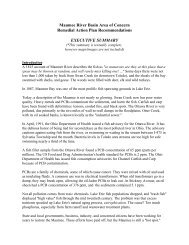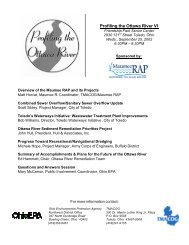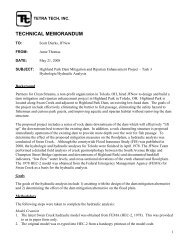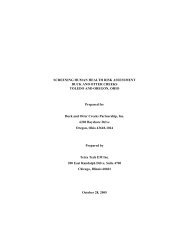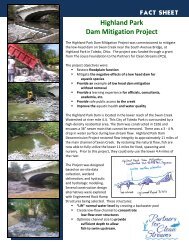Complete report - Partners for Clean Streams
Complete report - Partners for Clean Streams
Complete report - Partners for Clean Streams
Create successful ePaper yourself
Turn your PDF publications into a flip-book with our unique Google optimized e-Paper software.
EPA on sites of 5 acres or greater (on-going).<br />
Lead Organization:<br />
US EPA, Ohio EPA<br />
NPDES Phase II<br />
1999<br />
Description:<br />
NPDES MS4 Storm Water Permit<br />
US EPA promulgated NPDES Phase II in December 1999. By March 2003, regulated<br />
smaller communities with service populations under 100,000 will be required to obtain<br />
NPDES permit coverage. Their permits will require such items as: development and<br />
en<strong>for</strong>cement of a program which will detect and eliminate illicit discharges;<br />
development of MS4 maps and the establishment of ordinances and of en<strong>for</strong>cement<br />
procedures; produce public education materials that describe the impacts of storm<br />
water and actions to reduce pollution and must comply with state public notice<br />
requirements regarding the adoption of plans, policies, and ordinances. In addition,<br />
their permits will require the development of a program to address sediment and<br />
erosion control <strong>for</strong> all construction sites equal to or greater than 1 acre. The program<br />
must include an ordinance or other regulatory mechanism to require sediment and<br />
erosion controls and include the following components: pre-construction review of<br />
plans, procedures to receive/consider public comment, regular inspections during<br />
construction. The program must meet minimum standards set by Ohio EPA’s general<br />
NPDES construction permit.<br />
General NPDES <strong>for</strong> Storm Water Associated with Construction Activity<br />
By March 2003, small construction sites (between 1 and 5 acres) will be required to<br />
obtain NPDES permit coverage <strong>for</strong> their storm water discharges associated with<br />
construction activity. At that time, the exclusion provided to public entities with<br />
service populations under 100,000 will also end.<br />
Lead Organization:<br />
US EPA, Ohio EPA<br />
In<strong>for</strong>mal Programming<br />
Ongoing<br />
Description:<br />
Several communities have in<strong>for</strong>mal programs that are complaint driven or by simple<br />
observation (dry-weather discharges).<br />
Annual Dry Weather Field Survey<br />
Ongoing<br />
Description:<br />
Dry weather surveys are a part of the NPDES Storm Water permit requirements.<br />
Under Phase I the City of Toledo’s MS4 permit required them to establish and/or<br />
modify dry weather screening methodology to detect presence of illicit connections<br />
within 6 months of receiving the permit. Toledo is also required to conduct annual dry<br />
weather field screening of 20% (or 30 outfalls) of their major outfalls per year.<br />
Sampling parameters include: odor, color, turbidity, floatables, estimated flow, pH,<br />
phenols, chlorine, copper, and detergents.<br />
When Phase II is implemented in March 2003, regulated small communities will be<br />
Activities and Accomplishments<br />
in the Maumee Area of Concern<br />
145<br />
Issue 4: Urban Runoff



